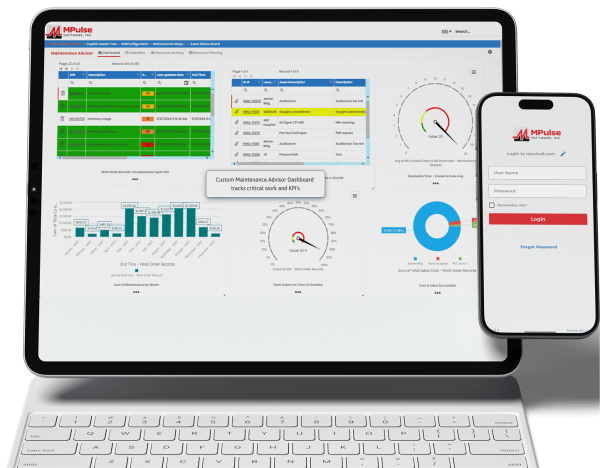The ability to reduce maintenance expenses, minimize downtime, extend equipment life, and boost productivity sounds like a dream come true for manufacturing organizations.
Plant maintenance software helps manufacturers with reliable scheduling, tracking, and reporting tools for equipment and facilities maintenance. Together, these features can reduce risk and improve safety.
But, how can plant maintenance software help your organization? You need six key components.
Table of Contents
Asset Management
Asset management in plant maintenance software tracks your assets over their entire life cycle to maximize value. You can keep tabs on all asset types, including equipment, buildings, grounds, rooms, and vehicles. The software also helps you document each asset’s purchase date, purchase price, startup date, and warranty expiration date. Plus, you create a historical record with every work order by calculating the labor costs and linking the cost of the parts and inventory used for the job.
Plant management software can help your team gather the right data, as well as enable your organization to get the most out of its investments. You’ll also know which assets most directly impact production capacity, and which ones would take a significant investment to replace. With asset management features, you can purchase, operate, maintain, upgrade, or dispose of assets in the most cost-effective manner.
Work Order Management
Work order features enable plant maintenance managers and technicians to create, update, and manage service requests. That helps improve response times and completion rates, as well as provides your team with better access to historical data and other important details. You also eliminate lost information between shifts, reducing confusion and errors. So, you get the highest priority work done, while making sure lower priority work doesn’t slip through the cracks.
Your plant maintenance software should easily receive work orders from an unlimited number of requesters, allow manual addition of requests, or automate tasks via preventive maintenance schedules. Also, look for features that automate the approval and assignment of work order requests, as well as automated confirmations for requesters, managers, and technicians.
Data Collection and Reporting
Plant maintenance software should enable you to create, update, and report on maintenance data. Reporting functions can help you keep a close eye on the key indicators you choose. These reports give you the ability to accurately assess how your department is functioning and where you might make changes to improve. It can help reduce operational costs by using detailed tracking tools for financial and business metrics.
Having hard numbers not only helps you run your plant, but it also allows you to measure and use a whole host of key performance indicators. You’ll have easy access to the numbers you need to make important decisions. Additionally, the software should quickly produce status reports and documents that give details or summaries of your team’s maintenance work. With solid data and easy-to-read reports, your organization can make good decisions based on hard evidence, which will improve its ability to compete effectively and efficiently.
Parts & Supplies Inventory Management
Parts and supplies inventory management helps your facility save time and money by improving tracking, stocking, ordering, and inventory processes. That helps you prevent time- and money-wasting problems like running out of parts, searching for lost parts, or duplicating inventory you didn’t know you had.
Look for software that includes stocking levels, reorder points, storage locations, and supplier information. You want the ability to track various units of measure for a single inventory item. For example, you might purchase oil by the barrel but use it by the quart.
With parts and supplies inventory management features, you can control your cost of maintenance. You also get your fastest return on investment (ROI) for plant maintenance software by implementing inventory management because, for most organizations, a large portion of capital sits in the stockroom.
Asset Status Board
One feature that many plants find invaluable is an asset status board. With this feature you can see the status of your entire asset inventory on one screen. It’s an easy way to monitor the health of your assets and get rapid access to business-critical information. That enables your team to respond faster when assets need attention or repair.
MPulse Asset Status Board will quickly show you the status of your entire asset inventory, on one screen.
-
- A cell can represent a single production asset or grouping of assets.
- The color of the cells changes as asset status changes.
- Click into any cell to view maintenance requests or current work orders for that cell.
- Work requests can be processed directly from the Asset Status Board.
Preventive Management
Preventive maintenance features will generate a schedule of PM tasks, making it simpler to follow the manufacturer’s guidelines. These schedules and inspections help spot issues before they occur. Schedule maintenance intervals based on time, operating hours, or part condition—triggering a work order just before the point when system inefficiencies or failures begin to occur. Preventive maintenance features also ensure equipment is properly calibrated and lubricated when it needs to be.
When a maintenance team establishes and regularly performs PM tasks that contribute to the upkeep of assets, an organization can sidestep serious problems that arise as a result of neglect, as well as delay more expensive maintenance. When your organization’s equipment hasn’t been maintained properly, you’re going to experience more breakdowns. That translates into lost dollars and intense pressure on the maintenance team to get production running again.
MPulse work order features can help you juggle an ever-increasing workload and a seemingly unending stream of plant maintenance information data. Contact us to learn more.






